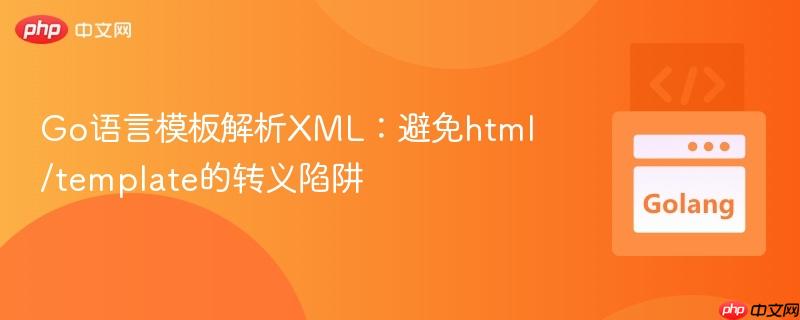
本文探讨了在go语言中使用html/template解析xml文件时,xml声明(如<?xml ...?>)被错误转义的问题。我们将深入分析html/template为何不适用于xml,并提供两种主要解决方案:一是切换到不进行html转义的text/template包,二是介绍go标准库中专门用于结构化xml处理的encoding/xml包,以确保xml内容的正确生成。
在Go语言的Web开发中,我们经常需要生成动态内容。html/template包是Go标准库提供的一个强大工具,用于安全地生成HTML输出,它会自动对内容进行HTML转义,以防止跨站脚本攻击(XSS)。然而,当尝试使用html/template来解析和生成XML文件时,这种自动转义机制反而会带来问题,特别是对于XML声明(<?xml ...?>)中的尖括号。
考虑以下XML文件 xml/in2.xml:
<?xml version="1.0" encoding="utf-8"?>
<in2>
<unique>{{.}}</unique>
<moe>100%</moe>
</in2>当使用html/template.ParseFiles()加载此模板,并尝试执行时,输出结果可能会变成这样:
<?xml version="1.0" encoding="utf-8"?>
<in2>
<unique>something</unique>
<moe>100%</moe>
</in2>可以看到,XML声明的第一个尖括号<被错误地转义成了
立即学习“go语言免费学习笔记(深入)”;
以下是导致此问题的示例Go代码:
package main
import (
"fmt"
"net/http"
"html/template" // 导入了html/template
"os"
"bytes"
)
// 模拟HTTP响应写入器,用于捕获输出
type mockResponseWriter struct {
header http.Header
buf *bytes.Buffer
status int
}
func (m *mockResponseWriter) Header() http.Header {
if m.header == nil {
m.header = make(http.Header)
}
return m.header
}
func (m *mockResponseWriter) Write(b []byte) (int, error) {
return m.buf.Write(b)
}
func (m *mockResponseWriter) WriteHeader(statusCode int) {
m.status = statusCode
}
// 使用html/template处理XML的函数(存在问题)
func in2HTMLTemplate(w http.ResponseWriter, r *http.Request) {
w.Header().Set("Content-Type", "text/xml")
// 注意:这里使用了 html/template
t, err := template.ParseFiles("xml/in2.xml")
if err != nil {
fmt.Println("Error parsing HTML template:", err)
http.Error(w, "Failed to parse template", http.StatusInternalServerError)
return
}
unique := "something"
err = t.Execute(w, unique)
if err != nil {
fmt.Println("Error executing HTML template:", err)
http.Error(w, "Failed to execute template", http.StatusInternalServerError)
}
}
func main() {
// 创建模拟的XML模板文件
os.MkdirAll("xml", 0755)
err := os.WriteFile("xml/in2.xml", []byte(`<?xml version="1.0" encoding="utf-8"?>
<in2>
<unique>{{.}}</unique>
<moe>100%</moe>
</in2>`), 0644)
if err != nil {
fmt.Println("Error creating xml/in2.xml:", err)
return
}
fmt.Println("--- 使用 html/template (存在转义问题) ---")
bufHTML := new(bytes.Buffer)
req, _ := http.NewRequest("GET", "/", nil)
res := &mockResponseWriter{buf: bufHTML}
in2HTMLTemplate(res, req)
fmt.Println(bufHTML.String())
}运行上述代码,你会看到输出的XML声明中的<被转义。
解决此问题的最直接方法是使用Go标准库中的另一个模板包——text/template。与html/template不同,text/template不会对内容进行任何自动转义,它仅仅是根据提供的模板和数据生成纯文本输出。这使得它非常适合生成XML、JSON或其他非HTML格式的文本文件。
以下是使用text/template修正后的代码:
package main
import (
"fmt"
"net/http"
"text/template" // 导入了 text/template
"os"
"bytes"
)
// 模拟HTTP响应写入器(同上)
type mockResponseWriter struct {
header http.Header
buf *bytes.Buffer
status int
}
func (m *mockResponseWriter) Header() http.Header {
if m.header == nil {
m.header = make(http.Header)
}
return m.header
}
func (m *mockResponseWriter) Write(b []byte) (int, error) {
return m.buf.Write(b)
}
func (m *mockResponseWriter) WriteHeader(statusCode int) {
m.status = statusCode
}
// 使用text/template处理XML的函数(正确方案)
func in2TextTemplate(w http.ResponseWriter, r *http.Request) {
w.Header().Set("Content-Type", "text/xml")
// 注意:这里使用了 text/template
t, err := template.ParseFiles("xml/in2.xml")
if err != nil {
fmt.Println("Error parsing Text template:", err)
http.Error(w, "Failed to parse template", http.StatusInternalServerError)
return
}
unique := "something"
err = t.Execute(w, unique)
if err != nil {
fmt.Println("Error executing Text template:", err)
http.Error(w, "Failed to execute template", http.StatusInternalServerError)
}
}
func main() {
// 创建模拟的XML模板文件
os.MkdirAll("xml", 0755)
err := os.WriteFile("xml/in2.xml", []byte(`<?xml version="1.0" encoding="utf-8"?>
<in2>
<unique>{{.}}</unique>
<moe>100%</moe>
</in2>`), 0644)
if err != nil {
fmt.Println("Error creating xml/in2.xml:", err)
return
}
fmt.Println("--- 使用 text/template (正确方案) ---")
bufText := new(bytes.Buffer)
req, _ := http.NewRequest("GET", "/", nil)
resText := &mockResponseWriter{buf: bufText}
in2TextTemplate(resText, req)
fmt.Println(bufText.String())
}运行这段代码,你会发现XML声明被正确地保留,没有发生转义。
注意事项:text/template不会进行任何内容转义,这意味着如果你在模板中插入了用户提供的数据,并且这些数据可能包含特殊字符(例如XML本身中的<, >, &),你需要自行处理这些字符的转义,以确保生成的XML是格式良好且安全的。
如果你的需求不仅仅是填充XML模板,而是更侧重于结构化地生成或解析XML数据,那么Go标准库的encoding/xml包是更专业和强大的选择。这个包允许你将Go结构体(struct)直接编码(Marshal)成XML,或从XML解码(Unmarshal)到Go结构体。它会自动处理XML的格式化和特殊字符转义。
以下是一个使用encoding/xml生成XML的示例:
package main
import (
"encoding/xml"
"fmt"
)
// 定义与XML结构对应的Go结构体
type In2 struct {
XMLName xml.Name `xml:"in2"` // 定义根元素的名称
Unique string `xml:"unique"`
Moe string `xml:"moe"`
}
func generateXMLWithEncodingXML() (string, error) {
data := In2{
Unique: "something_else",
Moe: "100%",
}
// MarshalIndent 将结构体编码为带缩进的XML
// xml.Header 会添加标准的XML声明 <?xml version="1.0" encoding="utf-8"?>
output, err := xml.MarshalIndent(data, "", " ")
if err != nil {
return "", err
}
return xml.Header + string(output), nil
}
func main() {
fmt.Println("\n--- 使用 encoding/xml (结构化XML处理) ---")
xmlOutput, err := generateXMLWithEncodingXML()
if err != nil {
fmt.Println("Error generating XML with encoding/xml:", err)
} else {
fmt.Println(xmlOutput)
}
}运行此代码将输出:
--- 使用 encoding/xml (结构化XML处理) ---
<?xml version="1.0" encoding="utf-8"?>
<in2>
<unique>something_else</unique>
<moe>100%</moe>
</in2>encoding/xml包的优势在于它提供了类型安全的XML操作,适用于复杂的XML结构和双向数据绑定。它会自动处理XML声明和内部数据内容的转义,确保生成的XML始终是有效的。
根据您的具体需求,选择合适的工具至关重要。对于本例中简单的XML模板填充,text/template是最佳的直接替代方案。如果您的XML操作涉及更复杂的结构或需要双向转换,那么encoding/xml将是更 robust 的选择。
以上就是Go语言模板解析XML:避免html/template的转义陷阱的详细内容,更多请关注php中文网其它相关文章!

每个人都需要一台速度更快、更稳定的 PC。随着时间的推移,垃圾文件、旧注册表数据和不必要的后台进程会占用资源并降低性能。幸运的是,许多工具可以让 Windows 保持平稳运行。

Copyright 2014-2025 https://www.php.cn/ All Rights Reserved | php.cn | 湘ICP备2023035733号